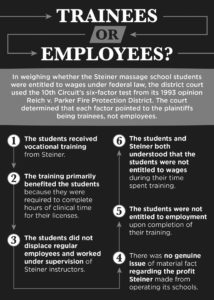

Had a federal appeals court decided Nesbitt v. FCNH differently, it might have upended the business models of numerous vocational schools and training programs.
But despite the plaintiffs’ claims that a group of massage therapy schools should have paid them for clinical work they performed as students for the school’s paying clients, the 10th Circuit Court of Appeals found they weren’t employees under federal law. To reach that conclusion, the appellate panel — and the lower federal court — used the 10th Circuit’s 25-year-old test to determine whether trainees are entitled to minimum wage under the Fair Labor Standards Act.
The Nov. 9 decision shows employers that the 10th Circuit is wont to stick to its precedent in determining whether students or interns should be paid, even as other circuits and the U.S. Department of Labor have recently offered different tests.
Steiner Education Group, which runs a group of massage therapy schools in 14 states including Colorado, faced a class action from former students who said the company profited from selling the clinical sessions they performed as “free labor.” The plaintiffs also said the schools gave them almost no real training or oversight during those sessions. Named plaintiff Rhonda Nesbitt filed an FLSA lawsuit in federal district court in Colorado in 2014 alleging the company failed to pay her and other former students minimum wage.
U.S. District Judge R. Brooke Jackson granted summary judgment in favor of Steiner in November 2016, finding the plaintiffs weren’t FLSA employees. He applied the 10th Circuit’s test from its 1993 opinion Reich v. Parker Fire Protection District, which looks at six factors regarding the work the students performed and the training they received. No single factor in the Reich test decides whether a plaintiff is an FLSA employee, and courts consider the “totality of circumstances” to make the determination.
But among the reasons the massage students didn’t qualify as employees, according to the district court, was that the unpaid clinical sessions primarily benefited the students, not Steiner; the students were earning clinical hours to fulfill a requirement to become licensed massage therapists.
On appeal, Nesbitt argued that Reich was the wrong test for the court to apply and that Marshall v. Regis Educational Corp was more appropriate. In that 1981 opinion, the 10th Circuit found the student resident hall assistants weren’t employees under the FLSA. The plaintiff said the Regis standard considers a larger educational context beyond the six factors set forth in Reich.
Nesbitt also asked the court to consider the “primary beneficiary test” the Second Circuit devised in its 2015 decision Glatt v. Fox Searchlight Pictures. That was “a case involving unpaid college interns, not a mandatory clinical training program leading to a state-licensed profession,” the 10th Circuit noted. The panel rejected the Glatt test and stuck with Reich, “which relies on the totality of the circumstances and accounts for the economic reality of the situation.”
The U.S. Department of Labor announced in January it was discarding its six-factor test, which the 10th Circuit partly adopted for its Reich framework, in favor of the 2nd Circuit’s primary beneficiary test. While similar to Reich, the primary beneficiary test weighs seven non-exhaustive factors to determine which party benefits more from the arrangement: the employer or the student/intern.
Although the Labor Department’s test switch was significant, Nesbitt v. FCNH shows the agency’s policy moves only have so much influence on the courts, according to employer-side wage-and-hour attorney Martine Tariot Wells, a shareholder at Brownstein Hyatt Farber Schreck in Denver.
“When we’re advising employers, we say the U.S. Department of Labor’s guidance … is persuasive and good guidance and tells us what the federal government is going to do … but it’s not binding authority on the courts,” Tariot Wells said. That also helps insulate the courts from the shifting politics — and hence the shifting policies — of agencies like the Labor Department. She added that “the courts will give some level of deference to the administrative agency,” but it can vary.

The 2nd, 6th, 9th and 11th circuits have adopted the primary beneficiary test, and the 10th Circuit’s decision seems to portend a circuit split in how courts determine FLSA employees. But because the tests are so similar, the Supreme Court is unlikely to take up the issue unless a case comes along that might have seen a much different result had the court used a different test, Tariot Wells said.
Tariot Wells said the decision underlines how employers that run vocational schools and training programs across several states should mind not only the various state laws governing employee classification but also the somewhat differing circuit case law. “It just sort of complicates the analysis.”
In her appeal, Nesbitt had two main contentions about how the district court used the Reich test: how much actual supervision the trainees received during their clinicals and how much profit the school made off their sessions with clients.
Nesbitt claimed that while instructors were on the premises, they never actually observed the students giving massages. But Steiner maintained it satisfied state requirements for clinical instruction and supervision. Regardless of which party was right, the 10th Circuit determined, the “floor was met.”
“At no time did the students function as regular employees; they were students learning a trade on vocational school premises,” according to the panel opinion by Judge Paul Kelly. “The presence of supervisory licensed massage therapists and teaching assistants to oversee them sets this case apart from situations where students all but carried out the duties of regular employees.”
Nesbitt argued Steiner was the primary beneficiary because the school profited from the clinical sessions while the students received marginal beneficial training. Steiner’s actual revenue from the clinicals never came to light in the case, and Steiner claimed it never made any profits from the sessions when factoring in overhead and operational costs.
But the fact that the students benefited from the training hours toward their licenses rendered irrelevant any profit the school might have made off their work, the 10th Circuit panel said. “We agree with the district court that ‘the clinics had an obvious benefit for [the students],’” the panel said.
— Doug Chartier

